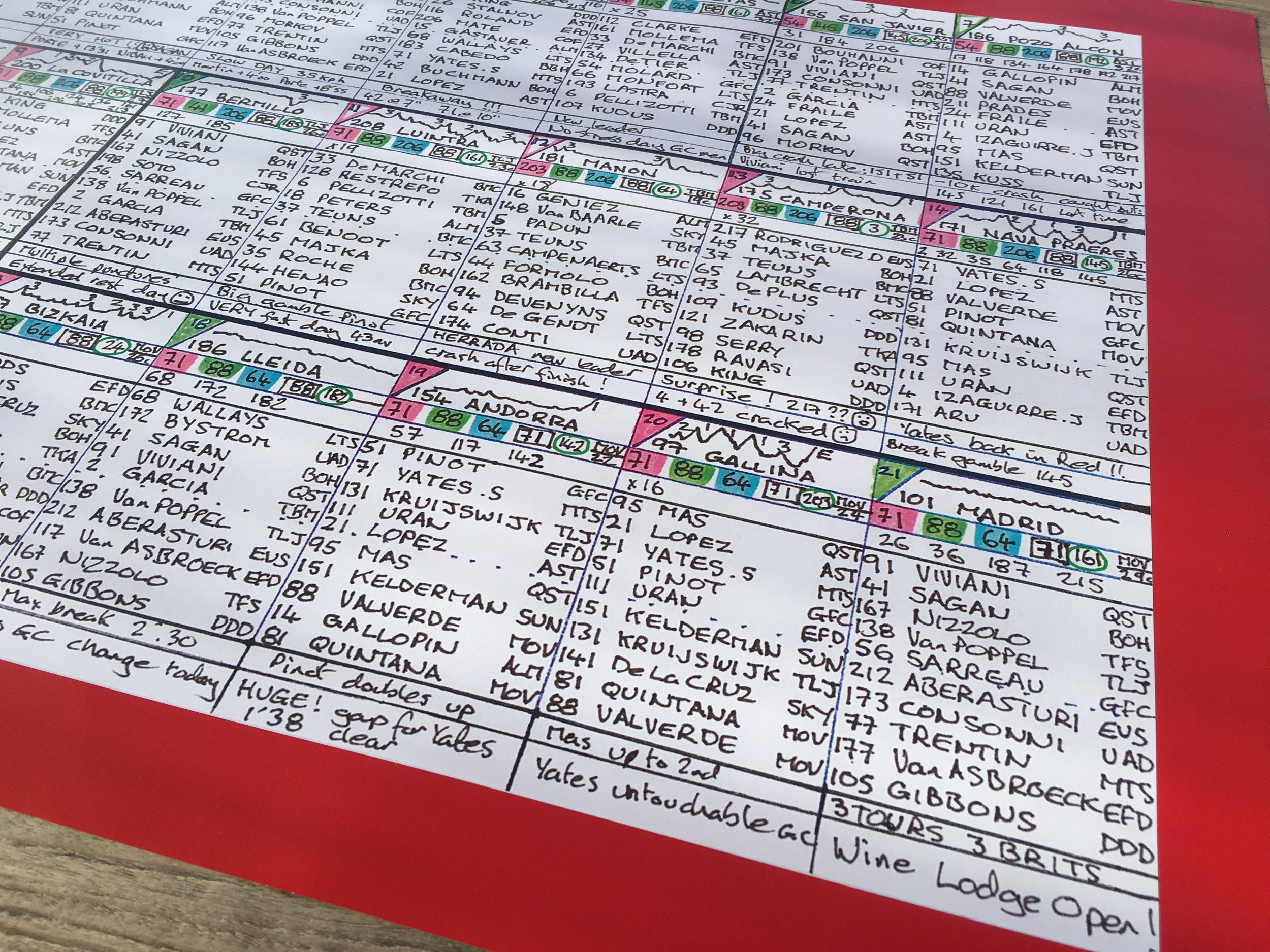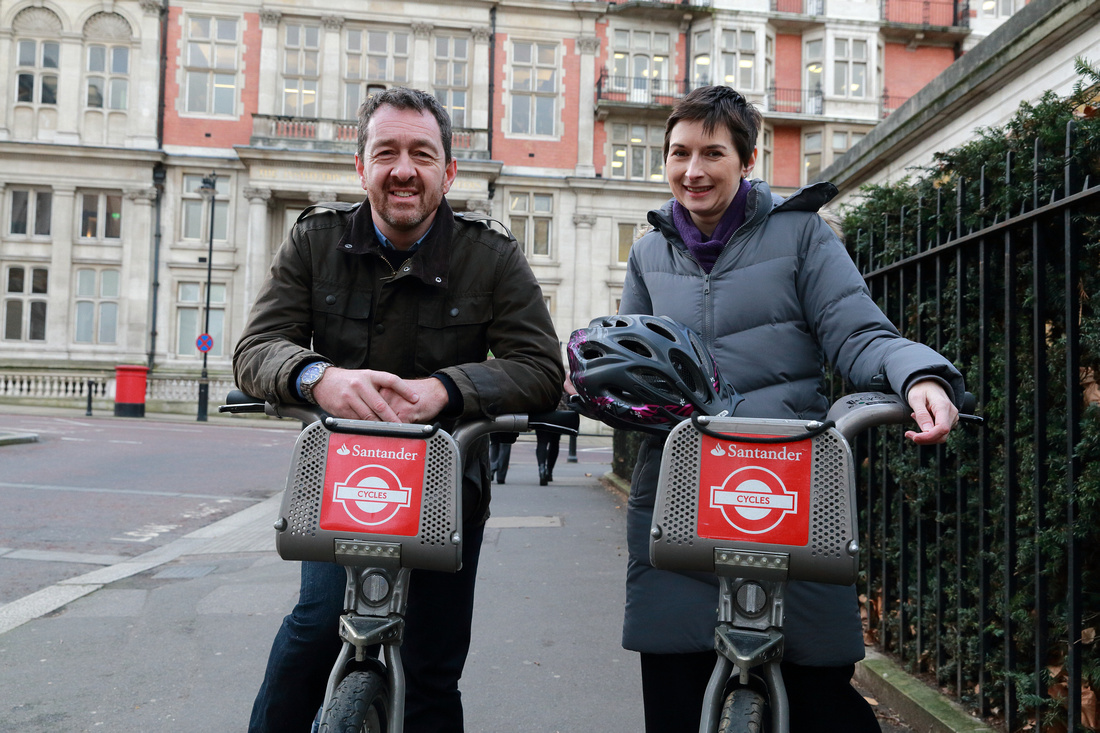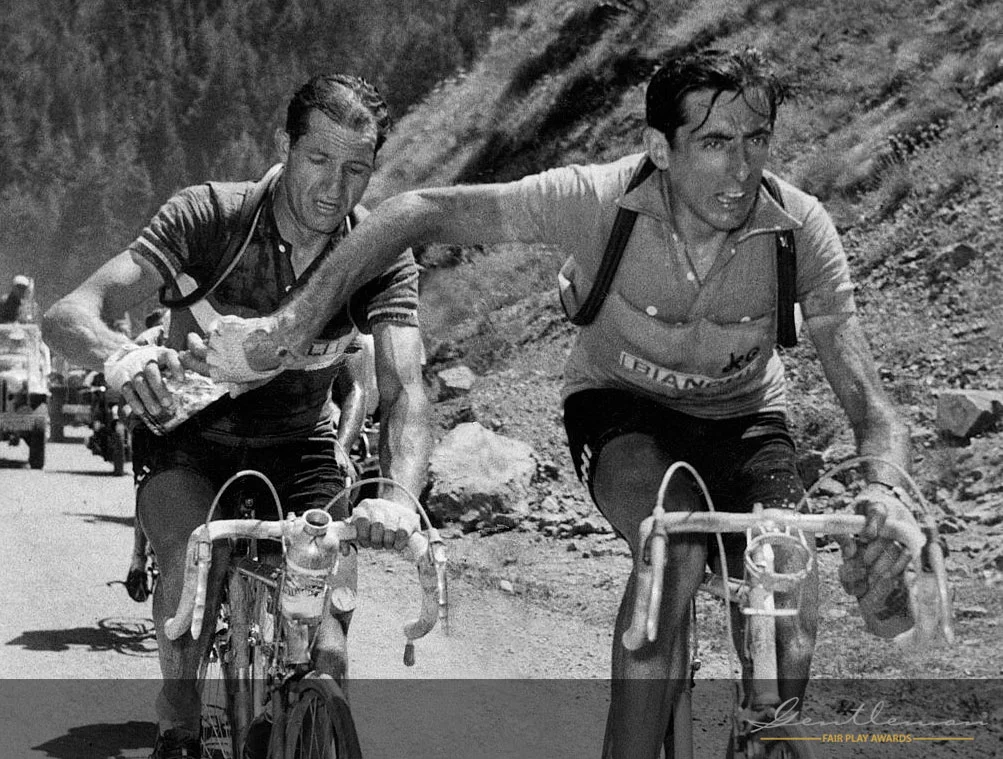On 13th July 1967, on the 13th stage of that year’s Tour de France, the British rider Tommy Simpson was climbing the dreaded Mont Ventoux when he started to veer from side to side of the road. Insisting that he be “put back on my bike” he continued until he was 1.5 km from the summit when he finally collapsed still clipped into his pedals, and died. A mixture of amphetamines and alcohol were later found in his bloodstream causing heat exhaustion and dehydration. Tomorrow will see this year’s tour pass the memorial which marks that spot where the brave Tommy breathed his last gasp and pedalled his final stroke.
Read MoreL'Etape du Tour 2016: "Courage, Chapeau et Bonne Chance"
This weekend sees 15,000 amateur cyclists from all around the world attempt a stage of the Tour de France when they undertake the L'Etape du Tour. Riders will follow the same route on Sunday that the professionals will be tackling on Stage 20 on 23rd of July from Megeve to Morzine. They will complete 3,300m of climbing on the 146km route and have to conquer the famous Alpine cols of Aravis, Colombier and Joux Plane.
Read MoreMark Cavendish: Lessons in Winning a Sprint Stage
Today sees the end of an exciting week of racing at the Tour de France - especially for fans of Mark Cavendish. Cav took three stage wins which makes him the second most successful Tour stage winner of all time, after the legendary Eddy Merckx. Many who had written Cav off as being 'finished' had to eat their words as he used skills learnt on the track to lunge ahead of André Greipel, beating him by millimetres! Ride Velo thought we'd take this opportunity to celebrate the sprint finish by revealing the science, tactics and psychology that goes into achieving the top podium position.
Read MoreRough Guide to the Tour de France
The Tour de France, the most famous bike race in the world, starts this weekend, Saturday 2nd July. If you’re a little rusty on your cycling knowledge and mix up your sticky bottles with your bidon, you may want to brush up on your jargon. Here’s our rough guide to the Tour to see you through the next three weeks; everything you wanted to know about the Tour but were afraid to ask.
Read MoreIntermediate Cycle Maintenance
If you want to learn more about looking after bicycles you have three options: dismantling your bike in your bedroom, signing up for a City and Guilds or going on a Look Mum No Hands! intermediate cycle maintenance course. Here's a hint - the third option is definitely the path of least resistance. Ride Velo hasn't ever tried options one or two, but three is the safest - and we think it's the most fun too.
Read MoreReclaim the Streets!
Speaking to The Times this week, Chris Boardman asked how Britain can call itself a cycling nation when the current government invests £1 a head per year (as opposed to £24 a head in Holland) in cycling infrastructure.
“It gets me angry,” he said. “It’s insulting that it’s even called an investment strategy. Over £600 million to refurbish Bank tube station and the government invests £300 million across the entire country spread over five years for cycling and walking… ‘Insulting’ is the word.”
Chris Boardman is 'angry'
Boardman’s frustration is shared by many of us, especially when you consider that the arguments for investing in cycling are so strong on so many levels: pollution, health, business. “It’s the most cost-effective form of transport you can make,” he asserts.
The government’s reluctance to properly invest in and encourage cycling is confusing. Speaking at Spin London last week, Boardman was non-plussed himself, and said that it must be the Treasury who are just blinkered and can’t see it. But our reliance and devotion to the car was explained with clarity some forty years ago by the philosopher and Catholic priest, Ivan Illich.
Philiosopher Ivan Illich
Some of Illich’s most interesting ideas can be found in his 1974 work, “Energy and Equity” which proposes the concept of ‘counter-productivity’ when institutions of modern industrial society impede their purported aims. For example, he calculated that, in 1970s America, if you add the time spent to work to earn money to buy a car, the time spent in a car (including traffic jams), the time spent in hospitals because of accidents, the time spent in the oil industry and so on, and you divide that by the number of kilometres travelled per year per person, the average speed of each car journey is in fact only 6km per hour.
Even without taking into account the amount of time spent working to pay for a car, the average rush hour speed among cars in Central London is about the same as a horse drawn cart in the 1800s and less than that of the modern cyclist.
And that bike takes up such little space. As Illich says, eighteen bikes can be parked in the space of one car. Thirty can move along in the space taken by a moving car. To move 40,000 people across a bridge in an hour requires twelve lanes of cars, four by bus, three by train and only two by bicycle.
If houses were designed like cities...
As we have become slaves to the car our cities have evolved in a way that no one would have ever designed them in the first place. To make room for cars we have sacrificed an enormous amount of our personal space. A child cannot play in the street and is restricted to their personal garden, if they have one, or must go to a designated park or play area to which they may have to be driven to. Our Victorian streets were never designed to have cars parked either side of them for their entire length.
Victorian streets were not designed for cars
In the suburbs, people can’t get around conveniently because they are far away from everything. To make room for cars, distances have increased. People live far away from school, from work, from the supermarket. The car wastes more time than it saves and creates more distance than it overcomes.
If we continue our slavish reliance on the car the only logical conclusion is to further develop our cities in the image of Los Angeles or other sprawling urbanizations. They are splintered communities, strung out along empty streets lined with identical developments, designed for driving as quickly as possible from work to home and vice versa. In some American streets the act of strolling in the streets at night is grounds for suspicion of a crime.
Why is it that in British society, the city, once regarded as a modern marvel, is now seen as a living hell, a place to escape from? Another philosopher from Illich’s era, Andre Gorz, made the point that, the car, of course, and the accompanying noise, smell, pollution and danger it creates has made our cities uninhabitable. To escape we need faster cars to travel motorways to satellite towns far away. “What an impeccable circular argument!” he says. Give us more cars and wider roads so we can escape the destruction caused by cars and polluted streets!
Why should we have a place for work, a separate place for living, another for shopping, a fourth for education and yet another for entertainment? The way our space is divided up disintegrates society. Transport policy is not an issue that should be decided on remotely, by itself, but as a wider plan for how we live as human beings, as parts of a social community.
“People,” writes Illich, “will break the chains of overpowering transportation when they come once again to love as their own territory their own particular beat, and to dread getting too far away from it.” But for this to be possible we have to make the city habitable and not trafficable. We need to reinvigorate neighbourhoods into real communities again which are shaped by the varied activities therein : working, living, learning, relaxing, communicating, managing a coexistence and finding a life in common.
This really should be at the crux of transport policy. We can make arguments about the health benefits of getting people on their bikes and the amount of money it will save citizens and the government in the long run. These are good points and have been made many times. And ignored. We need politicians with vision who have the courage to do something about improving the quality of life of its citizens in a more profound way.
Last month Barcelona announced ambitious plans to reduce traffic by 21%, freeing up 60% of streets currently used by cars to turn them into so-called "citizen spaces". The plan is based around the idea of mini neighbourhoods around which traffic will flow, and in which spaces will be repurposed to "fill our city with life."
Forget the little concessions, tax breaks here and there and incentives to do this or that. We need to be rebuilding our cities to make them vibrant, local, real places again. And you can’t do that as long we remain enslaved by the car.
How to Dress Vintage
Vintage cycling events have become massively popular in the last few years. The Tweed Run has been going for eight years and tickets for this year's London event sold out in just 30 seconds! The Eroica Britannia festival had its second outing last year and attracted 50,000 guests as well as winning the UK Festival Awards prize for the best non-music festival. This year, 4,500 are set to ride around the glorious Derbyshire countryside on pre 1987 vintage steeds, including Ride Velo and lots of our friends. If, like us, this is your first time, we're here to help you look the part!
Read MoreReasons to Follow the Giro d'Italia
What’s your favourite Grand Tour? Is it the glitz, glamour and massive publicity machine of the Tour de France? Perhaps you prefer the more informal Vuelta? For many a fan, and for many a professional rider, it’s the romance of the Maglia Rosa of the Giro d’Italia, not the Maillot Jaune, which gets the heart beating faster and the hairs to prick up on the back of the neck.
Read MoreTour de Yorkshire 2016
We’ve had the dramatic mountains of the Tour of the Basque Country. Last Sunday saw the Tour of Turkey pedal through that extraordinary meeting point of East and West in Istanbul. I even managed to catch a few km of the Tour of Croatia which looked beautiful and the exotic Tour of Kazakhstan is around the corner. Who else is going to get into the act? Well, today sees the 2nd edition of our very own Tour in God’s own country, the Tour de Yorkshire, from Friday 29th April to Sunday 1st May.
Velocipedia - Bicycles Designed From Memories
How hard is it to become a bike designer? What gives the geometry of a bicycle a certain beauty and how do you combine functionality with design? An Italian/American product designer has created a wonderful experiment which clearly shows it's much harder than it looks! By inviting 376 people, aged between 3 and 88, to draw a bicycle from memory, Gianluca Gimini has built up an unusual collection of crazy designs. None of them work - but that hasn't stopped the Bologna-based artist from rendering them as if they were production models - and the end result is stunning.
Read MoreFoffa Photo Love Shoot!
Look what fun we had when Foffa Bikes lent us a Plume and a Single Speed for the weekend!
Read MoreSustrans Man - the Cycling Warrior
It’s a brisk and chilly March morning but that doesn’t deter Crispin. The cold has never bothered him and he slings on his rucksack over his Sustrans T-shirt, pauses to wipe a smear from his John Lennon glasses and mounts the faithful Brompton. Crispin loves the fact that his company vehicle is a Brompton and he’s adorned it with various cycling stickers like ‘Cycologist’, ‘Burn Fat, Not Oil’, and his favourite, ‘Life Behind Bars’ with a picture of some drop handlebars.
Read MoreThe Proper Way to Fix a Puncture
Ride Velo recently went on a bike maintenance course and learnt the proper way to fix a puncture. However, we haven't had a puncture recently. What did happen, though, was that some nasty person nicked my wheels when my bike was chained up outside... So £200 on Wiggle later, I'd replaced all the stolen bits with nice shiny new ones, and some more for good measure. So, in the spirit of sharing (not stealing), here's how to fix a puncture properly:
Read MoreRapha Man - A Tale of an Epic Ride in Richmond Park
Sunday morning, 5.58 AM and Julian’s awake already. He leans over to the bedside table to turn the alarm off which is due to start blaring at 6. Best not wake up Alissa. Julian sneaks out from under the covers and pads down the landing in his boxers, stifling an expletive as he steps on a piece of lego on the landing floor, then silently curses the detritus of kids’ Games kit and school bags that greets him as he gets down to the hallway of the double fronted Victorian house in Wandsworth. A quick look in the mirror to check his paunch, then he’s in the large open plan kitchen extension. Extra strong pod in the Nespresso machine, Granola and yoghurt, glass of orange juice. He warms his bum on the Aga and pushes the dog’s nose away from his crotch. All the while eyeing up the Pinarello hanging up on the black bull’s horns. He’s had it for 2 weeks now but can’t stop admiring it.
Read MoreVintage Bike Shopping for Eroica
Ride Velo has never been to Romford before and, an hour into the journey, we were seriously considering why we were enduring the traffic jams to get across London to a place that we’ve successfully managed to avoid for several decades without worrying about it. If we’d known what an Aladdin’s cave we were about to enter we would never have questioned the sanity of spending a beautiful spring Sunday afternoon stuck in the car negotiating the dubious driving skills of the inhabitants of Essex, rather than enjoying the country lanes of the Kent Alps on a road bike.
Read MoreGet Set for the Spring Classics!
The European racing season is up and running! This weekend the curtain was raised when 199 riders set off from Ghent, the heartland of Belgian cycling, for the Omloop Het Nieuwsblad. Crowds and a hint of warm spring sunshine along with the whiff of yeasty beer greeted the peloton packed with stars, including Peter Sagan. The reigning World Champion was part of a breakaway that the peloton was unable to reel in but he was beaten to the finish by Belgium’s own Greg Van Avermaet of BMC Racing.
Read MoreBike Knowledge is Power!
Many of us are embarrassed to admit it but, despite many years on the bike, our basic maintenance skills aren’t quite up to scratch. I have to confess to struggling when putting a tyre back onto a wheel with numb fingers after a puncture on the roadside. More than once I’ve reverted to using a tyre lever to get that last bit over the rim. Shocking, I know, and I’ve suffered numerous pinch punctures afterwards as a result. And, as for gear indexing and replacing brakes, I’m ashamed to say that I’ve usually left this for the bike shop pros.
Read MoreThe History of the Six Day Races
"An athletic contest in which participants 'go queer' in their heads, and strain their powers until their faces become hideous with the tortures that rack them, is not sport. It is brutality." The New York Times, 1897
Read MoreElectric Bikes; Love 'em or Loathe 'em?
As cyclists who use their legs for power, Ride Velo can't help but feel superior to those who choose to rely on battery power - just look at the furore surrounding the suspected 'mechanical doping' of the U23 women's CX world championship race in Belgium on Saturday - proper cyclists don't use batteries! However, we can't deny that there are innumerable benefits to this recent technological boost to cycling. But do the pros outweigh the cons? Ride Velo investigates...
Read MoreVelodrome Virgin No More!
My New Year's resolution this year was to try out new and different forms of cycling outside my comfort zone. And although I live just a mile away from Herne Hill Velodrome, have watched lots of track racing there, made my kids do holiday training sessions and regularly helped out at the Inter-schools Championships, I'm ashamed to admit that I'd never ridden the track myself.
Read More





















































